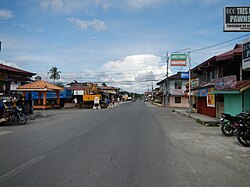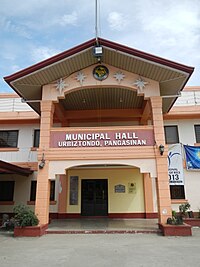Urbiztondo
Urbiztondo | |
|---|---|
| Municipality of Urbiztondo | |
 | |
 Seal | |
 Map of Pangasinan with Urbiztondo highlighted | |
 Urbiztondo Location within the Philippines | |
| Coordinates: 15°49′22″N 120°19′46″E / 15.8227°N 120.3295°ECoordinates: 15°49′22″N 120°19′46″E / 15.8227°N 120.3295°E | |
| Country | Philippines |
| Region | Ilocos Region |
| Province | Pangasinan |
| District | 2nd district |
| Named for | Juan Antonio de Urbiztondo |
| Barangays | 21 (see Barangays) |
| Government | |
| • Type | Sangguniang Bayan |
| • Mayor | Martin Raul S. Sison II |
| • Vice Mayor | Marilyn S. Sison |
| • Representative | Jumel Anthony I. Espino |
| • Councilors | Members |
| • Electorate | 34,586 voters (2019) |
| Area | |
| • Total | 81.80 km2 (31.58 sq mi) |
| Elevation | 14 m (46 ft) |
| Highest elevation | 30 m (100 ft) |
| Lowest elevation | 6 m (20 ft) |
| Population (2020 census) [3] | |
| • Total | 55,557 |
| • Density | 680/km2 (1,800/sq mi) |
| • Households | 10,418 |
| Economy | |
| • Income class | 3rd municipal income class |
| • Poverty incidence | 18.89% (2015)[4] |
| • Revenue | ₱167,208,638.45 (2020) |
| • Assets | ₱384,104,298.29 (2020) |
| • Expenditure | ₱127,920,002.51 (2020) |
| • Liabilities | ₱82,206,467.93 (2020) |
| Service provider | |
| • Electricity | Central Pangasinan Electric Cooperative (CENPELCO) |
| Time zone | UTC+8 (PST) |
| ZIP code | 2414 |
| PSGC | |
| IDD : area code | +63 (0)75 |
| Native languages | Pangasinan Ilocano Tagalog |
| Website | urbiztondopang |
Urbiztondo, officially the Municipality of Urbiztondo (Pangasinan: Baley na Urbiztondo; Ilocano: Ili ti Urbiztondo; Tagalog: Bayan ng Urbiztondo), is a 3rd class municipality in the province of Pangasinan, Philippines. According to the 2020 census, it has a population of 55,557 people. [3]
History[]
The municipality was named after Spanish governor-general General Antonio de Urbiztondo y Villasis who acted as Spanish Governor in the Philippines and was also conqueror of the Muslims in Jolo from 1850 to 1852. He then issued a decree founding the town and consequently the newly formed town was named “Urbiztondo” in his honor. The Municipality of Urbiztondo's establishment as a town was primarily due to Fr. Ramon Dalmau, the parish priest of San Carlos, who began its foundation in 1852, separating the said town from San Carlos now a city. The initiative in the emergence of Urbiztondo came from the pioneering fathers from San Carlos, Pangasinan. Its creation has been credited to Rev. Father Ramon Dalmau, curate of San Carlos who worked hard for its founding on November 28, 1853. It remained a visita of San Carlos in the year 1852. It was separated from San Carlos on the above date when it was assigned its own curate. The Dominicans accepted Urbiztondo as a vicariate in 1855 designating Rev. Father Francisco Treserra who is also responsible for relocating the town to the place where it is now located.
Barangays[]
Urbiztondo is politically subdivided into 21 barangays.
- Angatel
- Balangay
- Batangcaoa
- Baug
- Bayaoas
- Bituag
- Camambugan
- Dalanguiring
- Duplac
- Galarin
- Gueteb
- Malaca
- Malayo
- Malibong
- Pasibi East
- Pasibi West
- Pisuac
- Poblacion
- Real
- Salavante
- Sawat
Climate[]
| Climate data for Urbiztondo, Pangasinan | |||||||||||||
|---|---|---|---|---|---|---|---|---|---|---|---|---|---|
| Month | Jan | Feb | Mar | Apr | May | Jun | Jul | Aug | Sep | Oct | Nov | Dec | Year |
| Average high °C (°F) | 31 (88) |
32 (90) |
33 (91) |
34 (93) |
33 (91) |
32 (90) |
31 (88) |
30 (86) |
31 (88) |
32 (90) |
32 (90) |
31 (88) |
32 (89) |
| Average low °C (°F) | 22 (72) |
23 (73) |
24 (75) |
25 (77) |
25 (77) |
25 (77) |
25 (77) |
25 (77) |
25 (77) |
24 (75) |
24 (75) |
23 (73) |
24 (75) |
| Average precipitation mm (inches) | 9 (0.4) |
11.4 (0.45) |
11.1 (0.44) |
5.4 (0.21) |
258 (10.2) |
315.6 (12.43) |
463.1 (18.23) |
663.2 (26.11) |
479.7 (18.89) |
121.9 (4.80) |
75.8 (2.98) |
16.8 (0.66) |
2,431 (95.8) |
| Average rainy days | 4 | 3 | 2 | 2 | 12 | 15 | 19 | 21 | 18 | 12 | 9 | 5 | 122 |
| Source: World Weather Online[5] | |||||||||||||
Demographics[]

| Year | Pop. | ±% p.a. |
|---|---|---|
| 1903 | 7,416 | — |
| 1918 | 8,538 | +0.94% |
| 1939 | 11,159 | +1.28% |
| 1948 | 15,721 | +3.88% |
| 1960 | 19,594 | +1.85% |
| 1970 | 23,385 | +1.78% |
| 1975 | 24,006 | +0.53% |
| 1980 | 27,348 | +2.64% |
| 1990 | 33,102 | +1.93% |
| 1995 | 35,746 | +1.45% |
| 2000 | 40,089 | +2.49% |
| 2007 | 43,430 | +1.11% |
| 2010 | 47,831 | +3.58% |
| 2015 | 50,170 | +0.91% |
| 2020 | 55,557 | +2.03% |
| Source: Philippine Statistics Authority [6] [7] [8][9] | ||
Economy[]
| Poverty Incidence of Urbiztondo | |
| Source: Philippine Statistics Authority[10][11][12][13][14][15] | |
References[]
- ^ Municipality of Urbiztondo | (DILG)
- ^ "2015 Census of Population, Report No. 3 – Population, Land Area, and Population Density" (PDF). Philippine Statistics Authority. Quezon City, Philippines. August 2016. ISSN 0117-1453. Archived (PDF) from the original on May 25, 2021. Retrieved July 16, 2021.
- ^ a b Census of Population (2020). "Region I (Ilocos Region)". Total Population by Province, City, Municipality and Barangay. PSA. Retrieved 8 July 2021.
- ^ https://psa.gov.ph/sites/default/files/City%20and%20Municipal-level%20Small%20Area%20Poverty%20Estimates_%202009%2C%202012%20and%202015_0.xlsx; publication date: 10 July 2019; publisher: Philippine Statistics Authority.
- ^ "Urbiztondo, Pangasinan: Average Temperatures and Rainfall". World Weather Online. Retrieved 31 October 2015.
- ^ Census of Population (2015). "Region I (Ilocos Region)". Total Population by Province, City, Municipality and Barangay. PSA. Retrieved 20 June 2016.
- ^ Census of Population and Housing (2010). "Region I (Ilocos Region)". Total Population by Province, City, Municipality and Barangay. NSO. Retrieved 29 June 2016.
- ^ Censuses of Population (1903–2007). "Region I (Ilocos Region)". Table 1. Population Enumerated in Various Censuses by Province/Highly Urbanized City: 1903 to 2007. NSO.
- ^ "Province of Pangasinan". Municipality Population Data. Local Water Utilities Administration Research Division. Retrieved 17 December 2016.
- ^ "Poverty incidence (PI):". Philippine Statistics Authority. Retrieved 28 December 2020.
- ^ https://psa.gov.ph/sites/default/files/NSCB_LocalPovertyPhilippines_0.pdf; publication date: 29 November 2005; publisher: Philippine Statistics Authority.
- ^ https://psa.gov.ph/sites/default/files/2003%20SAE%20of%20poverty%20%28Full%20Report%29_1.pdf; publication date: 23 March 2009; publisher: Philippine Statistics Authority.
- ^ https://psa.gov.ph/sites/default/files/2006%20and%202009%20City%20and%20Municipal%20Level%20Poverty%20Estimates_0_1.pdf; publication date: 3 August 2012; publisher: Philippine Statistics Authority.
- ^ https://psa.gov.ph/sites/default/files/2012%20Municipal%20and%20City%20Level%20Poverty%20Estima7tes%20Publication%20%281%29.pdf; publication date: 31 May 2016; publisher: Philippine Statistics Authority.
- ^ https://psa.gov.ph/sites/default/files/City%20and%20Municipal-level%20Small%20Area%20Poverty%20Estimates_%202009%2C%202012%20and%202015_0.xlsx; publication date: 10 July 2019; publisher: Philippine Statistics Authority.
External links[]
| Wikimedia Commons has media related to Urbiztondo, Pangasinan. |
- Urbiztondo Profile at PhilAtlas.com
- Municipal Profile at the National Competitiveness Council of the Philippines
- Urbiztondo at the Pangasinan Government Website
- Local Governance Performance Management System
- Philippine Standard Geographic Code
- Philippine Census Information
- Municipalities of Pangasinan
- Populated places on the Agno River
- Philippines geography stubs

